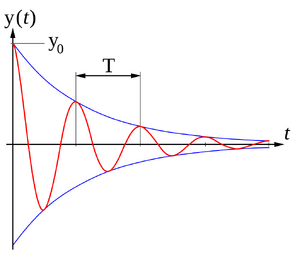Damped harmonic oscillator
We encounter the damped harmonic oscillator in real-world conditions. (Unlike the harmonic oscillator , which could only exist under ideal conditions). The energy of the oscillatory motion is partially converted into other forms of energy (for example, into internal energy or into the energy needed to overcome the frictional force) and a damped oscillation occurs. If we supply energy only at the beginning of the movement, the movement gradually disappears completely.
Damped Oscillation[edit | edit source]
As it was already said at the beginning, we encounter damped oscillation in the event that part of the energy of the oscillatory motion is transformed into another energy. The damping of the oscillation of the harmonic oscillator is dependent on the density of the medium, in which it oscillates. Damping is greater in water than in air. It also depends on the speed at which the oscillator oscillates.
Damped oscillation can be described by the equation y=e-(b.t)/2m. ym. sin(ωt +φ0), where b is the proportionality constant between the resistance force and the speed of the body and m is the mass of the body.
Damped oscillator properties[edit | edit source]
Unlike an undamped harmonic oscillator, where the amplitude is constant, in a damped harmonic oscillator the amplitude decreases exponentially (until it becomes zero after a certain time). The angular frequency ω will be smaller than it would be for an undamped oscillator under the same conditions, and is given by ω = (ω02 - δ2), where ω0 is the angular frequency of undamped oscillation and δ is the damping coefficient (quantity expressing the influence of the environment on the oscillatory motion of a mechanical oscillator). From the fact that the angular frequency of a damped harmonic oscillator will be smaller than that of an undamped one, we can further deduce that the frequency will also be smaller and the period higher.
Harmonic Oscillator Dynamics[edit | edit source]
The oscillatory motion of a damped harmonic oscillator is affected by the resistance of the environment.
Therefore, the total force acting on the oscillator is given by the vector sum of the force acting on the oscillator in deflection y towards the equilibrium position ( F o ) and the damping force, which has the opposite direction ( F t ).
Formula: F = Fo + Ft
Fo is a strong deflection directly proportional to y and spring stiffness k. Its formula: Fo= -k.y
Ft is a force directly proportional to the speed of the oscillator. It is given by the formula Ft=-b.v
Therefore, we can express the resulting force as: F= –k.y – b.v
Damping Types[edit | edit source]
Depending on the damping force acting on the oscillator, we can distinguish between weak, strong and critical damping.
Weak damping[edit | edit source]
We speak of weak damping in the event that the oscillator performs a periodic movement , but its amplitude decreases with time.
For the deflection amplitude at a given time: ym = ym0. e(-b.t)/2m
Heavy damping[edit | edit source]
We are talking about strong damping when the oscillator does not move periodically (it moves aperiodically). This means that it never exceeds its equilibrium position, only slowly (asymptotically) approaches it. For this movement, ω0 < δ also holds.
Critical damping[edit | edit source]
Critical damping occurs when the oscillator performs a so-called marginal aperiodic movement. This means that the oscillator does not oscillate, but reaches an equilibrium position in the shortest possible time.
The following holds for this damping: ω0 = δ
Links[edit | edit source]
Related Articles[edit | edit source]
Source[edit | edit source]
- http://fyzika.jreichl.com/main.article/view/162-tlumene-kmitani
- http://home.zcu.cz/~mika/MM/Motivace%20MM/kmity.html
- http://fyzika.fce.vutbr.cz/doc/vyuka_schauer/mechanicke_kmity.pdf
- https://cs.wikipedia.org/wiki/Tlumen%C3%A9_kmit%C3%A1n%C3%AD
- http://kdf.mff.cuni.cz/vyuka/materialy/analyticka_reseni_pohybu_castic_a_teles.pdf
- http://artemis.osu.cz/vops2/prikl/sem01.pdf
References[edit | edit source]
- LEPIL, Oldřich. A small lexicon of physics. 1. edition. Prometheus, 1995. ISBN 80-85849-77-1.
- LANK, Vladimír – VONDRA, Miroslav. Fyzika v kostce. 2. edition. 2002. ISBN 80-7200-335-6.



